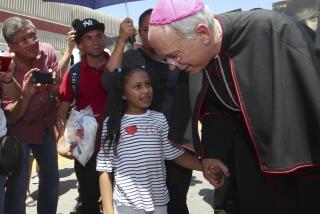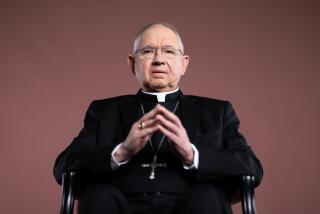COMMENTARY : Catholic Church in America Fails to Keep Pace With the Changes
- Share via
The Roman Catholic Church in America is in trouble, with no relief in sight.
In major cities across the country, diocesan officials have been forced to close parish churches. Faced with aging church buildings with high maintenance costs and the flight of middle-class Catholics to the suburbs, bishops in Detroit, Chicago, New York and elsewhere have taken drastic steps toward financial solvency. In the process, they have abandoned neighborhoods where the Catholic Church has functioned as the center of the community for immigrants of the last century.
But difficulties facing the Catholic Church in America are not confined to the cities. In the tiny town of Conrath, in northwest Wisconsin, parishioners of Holy Trinity Catholic Church are exploring affiliation with the Episcopal Church. Their disenchantment stems from an announcement by diocesan officials who, faced with a shortage of priests, have said they could no longer provide Holy Trinity with a pastor.
What lies behind the troubles? Some of them are wrought by social and demographic changes. Others can be traced directly to the Vatican.
The dilemma faced by the people of Conrath underscores one of the primary difficulties in American Catholicism--a shortage of priests. The Vatican’s stubborn resistance to relaxing its demand for clerical celibacy has diminished considerably the pool of men preparing for the priesthood, and that must surely be taken into account when assessing the fate of the American church.
The research of the Rev. Andrew Greeley, a sociologist and Catholic priest, highlights another problem. Greeley has shown that Pope Paul VI’s encyclical banning the use of artificial means of birth control has caused enormous damage to the American church. Ever since the publication of Humanae Vitae in 1968, American Catholics have felt that they could disobey the Pope on this matter while remaining good Catholics. Others became disillusioned altogether. If the Pope could be so wrong on birth control, they thought, he could be wrong on other matters as well.
Pope John Paul II has done little to allay those suspicions. His appointment of archconservatives to the American Catholic hierarchy conveys to many disaffected Catholics that he cares more about clinging to tradition than about listening to their concerns.
The Catholic Church in America will not collapse anytime soon. But the institution can no longer count on even its traditional source of renewal and growth, immigrants.
The Templo Calvario, in Santa Ana, illustrates a problem that the church is aware of but seems powerless to counter. Despite formal programs aimed at attracting incoming Latinos, the evidence in churches like Templo Calvario is that the church is losing considerable ground to the freewheeling Pentecostal congregations.
Templo Calvario is an Assemblies of God congregation whose members are almost entirely Latino, many of them new immigrants. The Rev. Danny de Leon draws thousands of Latinos to several services during the week. He estimates that 90% of his congregation grew up in the Catholic Church.
What do they find so attractive about the Pentecostal enthusiasm at Templo Calvario?
Many of the people I spoke with seemed to regard Catholicism as something they inherited at birth. Pentecostalism, on the other hand, represents an alternative, a tradition they could choose on their own. Many even adopted the evangelical language of exclusion; they spoke of becoming “Christian” when they became Pentecostals.
For his part, De Leon shies away from criticizing the Catholic Church directly, but he, and hundreds of Pentecostal preachers like him, show no signs of shying away from seeking the conversion of Latinos to Pentecostalism.
More to Read
Sign up for Essential California
The most important California stories and recommendations in your inbox every morning.
You may occasionally receive promotional content from the Los Angeles Times.










